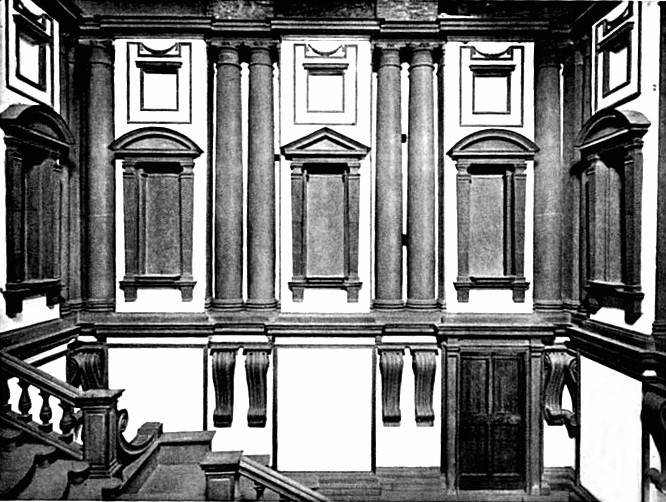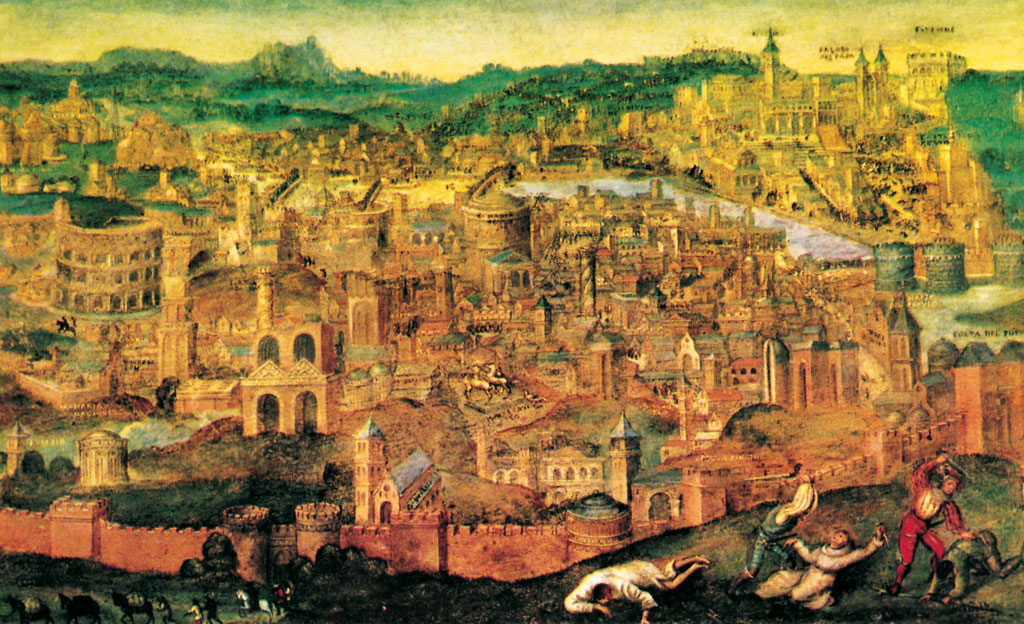|
Sagrestia Nuova
The Sagrestia Nuova, also known as the New Sacristy and the Medici Chapel, is a mausoleum that stands as a testament to the grandeur and artistic vision of the Medici family. Constructed in 1520, the mausoleum was designed by the Italian artist Michelangelo. Situated adjacent to the Basilica di San Lorenzo in Florence, Italy, the Sagrestia Nuova forms an integral part of the museum complex known as the Medici Chapels. History Premises The death of the two descendants of the Medici family, Giuliano de' Medici, Duke of Nemours, in 1516 and Lorenzo de' Medici, Duke of Urbino, in 1519, had deeply embittered Pope Leo X, respectively brother and uncle of the two, who wanted to ensure that they obtained a princely burial. It was also suggested by their cousin Giulio de' Medici, cardinal and later Pope Clement VII in 1523, commissioning Michelangelo's project for the façade for Basilica di San Lorenzo, engaging the artist in a new project for the basilica. The church had been the b ... [...More Info...] [...Related Items...] OR: [Wikipedia] [Google] [Baidu] |
Basilica Of San Lorenzo, Florence
The Basilica di San Lorenzo (Basilica of St. Lawrence) is one of the largest churches of Florence, Italy, situated at the centre of the main market district of the city, and it is the burial place of all the principal members of the Medici family from Cosimo il Vecchio to Cosimo III. It is one of several churches that claim to be the oldest in Florence, having been consecrated in 393 AD, at which time it stood outside the city walls. For three hundred years it was the city's cathedral, before the official seat of the bishop was transferred to Santa Reparata. San Lorenzo was the parish church of the Medici family. In 1419, Giovanni di Bicci de' Medici offered to finance a new church to replace an eleventh-century Romanesque rebuilding. Filippo Brunelleschi, the leading Renaissance architect of the first half of the fifteenth century, was commissioned to design it, but the building, with alterations, was not completed until after his death. The church is part of a larger monast ... [...More Info...] [...Related Items...] OR: [Wikipedia] [Google] [Baidu] |
Aedicula
In ancient Roman religion, an ''aedicula'' (plural ''aediculae'') is a small shrine, and in classical architecture refers to a niche covered by a pediment or entablature supported by a pair of columns and typically framing a statue,"aedicula, n." ''OED Online'', Oxford University Press, September 2020www.oed.com/view/Entry/3077 Accessed 29 September 2020."aedicule, n." ''OED Online'', Oxford University Press, September 2020www.oed.com/view/Entry/3079 Accessed 29 September 2020 the early Christian ones sometimes contained funeral urns. Aediculae are also represented in art as a form of ornamentation. The word ''aedicula'' is the diminutive of the Latin '' aedes'', a temple building or dwelling place. The Latin word has been Anglicised as "aedicule" and as "edicule". Classical aediculae Many aediculae were household shrines ( lararia) that held small altars or statues of the Lares and Di Penates. The Lares were Roman deities protecting the house and the family household gods ... [...More Info...] [...Related Items...] OR: [Wikipedia] [Google] [Baidu] |
Slaves (Michelangelo)
The Tomb of Pope Julius II is a sculptural and architectural ensemble by Michelangelo and his assistants, originally commissioned in 1505 but not completed until 1545 on a much reduced scale. Originally intended for St. Peter's Basilica, the structure was instead placed in the church of San Pietro in Vincoli on the Esquiline in Rome after the pope's death. This church was patronized by the Della Rovere family from which Julius came, and he had been titular cardinal there. Julius II, however, is buried next to his uncle Sixtus IV in St. Peter's Basilica, so the final structure does not actually function as a tomb. As originally conceived, the tomb would have been a colossal structure that would have given Michelangelo the room he needed for his superhuman, tragic beings. This project became one of the great disappointments of Michelangelo's life when the pope, for unexplained reasons, interrupted the commission, possibly because funds had to be diverted for Bramante's rebuilding o ... [...More Info...] [...Related Items...] OR: [Wikipedia] [Google] [Baidu] |
Niccolò Tribolo
Niccolò di Raffaello di Niccolò dei Pericoli, called "Il Tribolo" (1500 – 7 September 1550) was an Italian Mannerist artist in the service of Cosimo I de' Medici in his natal city of Florence. Life Niccolò di Raffaello began as an apprentice to a woodcarver but, while still in his teens, was taken up as an assistant by Andrea Sansovino. Giorgio Vasari, in his '' Vite'', mentioned numerous early figures and fountains by Tribolo that can no longer be traced. A court artist like his successor Bernardo Buontalenti, he was expected to function well as a member of a team; like Buontalenti's, his name has been overshadowed by greater personalities. For example, in the 17th and 18th centuries, connoisseurs attributed to Michelangelo some of Tribolo's drawings for sculptural niches and wall fountains, a tribute to Tribolo's bravura as a draughtsman and a sign of Michelangelo's influence on his style. From 1517 he had returned from Venice to Florence, working on his own. In hi ... [...More Info...] [...Related Items...] OR: [Wikipedia] [Google] [Baidu] |
Laurentian Library
The Laurentian Library (Biblioteca Medicea Laurenziana or BML) is a historic library in Florence, Italy, containing more than 11,000 manuscripts and 4,500 early printed books. Built in a cloister of the Medicean Basilica di San Lorenzo di Firenze under the patronage of the Medici pope Clement VII, the library was built to emphasize that the Medici were no longer just merchants but members of intelligent and ecclesiastical society. It contains the manuscripts and books belonging to the private library of the Medici family. The library building is renowned for its architecture that was designed by Michelangelo and is an example of Mannerism.Fazio, Michael; Moffett, Marian; Wodehouse, Lawrence, ''Buildings across Time'' (London: Lawrence King Publishing Ltd, 2009), pp. 308–310.Lotz, Wolfgang; Howard, Deborah, ''Architecture in Italy, 1500–1600'' (New Haven: Yale University Press, 1995), pp. 91–94. All of the book-bound manuscripts in the library are identified in its ''Codex ... [...More Info...] [...Related Items...] OR: [Wikipedia] [Google] [Baidu] |
Siege Of Florence (1529–1530)
The siege of Florence took place from 24 October 1529 to 10 August 1530, at the end of the War of the League of Cognac. At the Congress of Bologna, the Medici Pope Clement VII and Emperor Charles V agreed to restore the Medici family in Florence. A large Imperial and Spanish army under Philibert of Châlon, Prince of Orange and Pier Maria III de' Rossi surrounded the city, and, after a siege of nearly ten months, captured it, overthrowing the Republic of Florence and installing Alessandro de' Medici as the ruler of the city. The Florentines had thrown off Medici rule and established a republic after the Sack of Rome in 1527; the Florentine Republic had continued to participate in the war on the side of the French. The French defeats at Naples in 1528 and Landriano in 1529, however, led to Francis I of France concluding the Treaty of Cambrai with the Holy Roman Emperor Charles V. When Pope Clement VII and the Republic of Venice also concluded treaties with the Emp ... [...More Info...] [...Related Items...] OR: [Wikipedia] [Google] [Baidu] |
Alessandro De' Medici, Duke Of Florence
Alessandro is both a given name and a surname, the Italian form of the name Alexander. Notable people with the name include: People with the given name Alessandro * Alessandro Allori (1535–1607), Italian portrait painter * Alessandro Baricco (born 1958), Italian novelist * Alessandro Bega (born 1991), Italian tennis player * Alessandro Bordin (born 1998), Italian footballer * Alessandro Botticelli (1445–1510), Italian painter * Alessandro Bovo (born 1969), Italian water polo player * Alessandro Cagliostro (1743–1795), alias of occultist and adventurer Giuseppe Balsamo * Alessandro Calcaterra (born 1975), Italian water polo player * Alessandro Calvi (born 1983), Italian swimmer * Alessandro Cattelan (born 1980), Italian television preesenter * Alessandro Cortini (born 1976), Italian musician * Alessandro Criscuolo (1937–2020), Italian judge * Alessandro Del Piero (born 1974), Italian footballer * Alessandro Di Munno (born 2000), Italian footballer * Alessandro Eva ... [...More Info...] [...Related Items...] OR: [Wikipedia] [Google] [Baidu] |
Sack Of Rome (1527)
The Sack of Rome, then part of the Papal States, followed the capture of the city on 6 May 1527 by the mutinous troops of Charles V, Holy Roman Emperor during the War of the League of Cognac. Despite not being ordered to storm the city, with Charles V intending to only use the threat of military action to make Pope Clement VII come to his terms, a largely unpaid Imperial army formed by 14,000 Germans, many of Lutheran faith, 6,000 Spaniards and some Italian contingents occupied the scarcely defended Rome and began looting, slaying and holding citizens for ransom in excess without any restraint. Clement VII took refuge in Castel Sant'Angelo after the Swiss Guard were annihilated in a delaying rearguard action; he remained there until a ransom was paid to the pillagers. Benvenuto Cellini, eyewitness to the events, described the sack in his works. It was not until February 1528 that the spread of a plague and the approach of the League forces under Odet de Foix forced th ... [...More Info...] [...Related Items...] OR: [Wikipedia] [Google] [Baidu] |
Casa Buonarroti
Casa Buonarroti is a museum in Florence, Italy. The building was a property owned by the sculptor Michelangelo, which he left to his nephew, Leonardo Buonarroti. The house was converted into a museum dedicated to the artist by his great nephew, Michelangelo Buonarroti the Younger. Its collections include two of Michelangelo's earliest sculptures, the ''Madonna of the Stairs'' and the ''Battle of the Centaurs''. A ten-thousand book library includes the family's archive and some of Michelangelo's letters and drawings. The Galleria is decorated with paintings commissioned by Buonarroti the Younger and created by Artemisia Gentileschi and other early seventeenth-century Italian artists. History On March 3, 1508, Michelangelo, who had moved to Rome three years earlier to work on the Tomb of Pope Julius II, bought four adjoining buildings at the corner of via Ghibellina and via Santa Maria (now via Buonarroti), just north of the Basilica di Santa Croce. He acquired another adjacent stru ... [...More Info...] [...Related Items...] OR: [Wikipedia] [Google] [Baidu] |
Hades
Hades (; grc-gre, ᾍδης, Háidēs; ), in the ancient Greek religion and myth, is the god of the dead and the king of the underworld, with which his name became synonymous. Hades was the eldest son of Cronus and Rhea, although this also made him the last son to be regurgitated by his father. He and his brothers, Zeus and Poseidon, defeated their father's generation of gods, the Titans, and claimed rulership over the cosmos. Hades received the underworld, Zeus the sky, and Poseidon the sea, with the solid earth, long the province of Gaia, available to all three concurrently. In artistic depictions, Hades is typically portrayed holding a bident and wearing his helm with Cerberus, the three-headed guard dog of the underworld, standing to his side. The Etruscan god Aita and the Roman gods Dis Pater and Orcus were eventually taken as equivalent to Hades and merged into Pluto, a Latinisation of Plouton ( grc-gre, , Ploútōn), itself a euphemistic title often gi ... [...More Info...] [...Related Items...] OR: [Wikipedia] [Google] [Baidu] |





